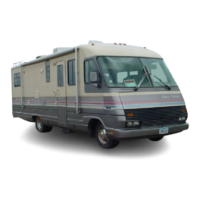rision
protection
given
by
the
recommended
coolant
solution.
Flushing
Cooling
System
Various
methods
and
equipment
may
be used to
perform
this
service.
If
special
equipment
such
as
a
back
flusher is used,
follow
equipment manufacturer's
instructions.
ENGINE ELECTRICAL
Jump
Starting
NOTE:
Do
not
push
or
tow
the
vehicle
to
start.
There
are
no
provisions
In
the
automatic
transmission
for
engagement
of
the
transmis-
sion
to
tum
over
the
engine.
Efforts
to
push
or
tow
the
vehicle
to
start-it
will
have
no
effect,.
Both
booster
and
discharged
battery
should
De
treated
carefully
when
using
jumper
cables. Follow
the
conditions
and
procedure
outlined
below, being'
careful
not
to
cause sparks. Departure fr()m these con-
ditions
or
procedures c()uld result in serious personal
injury (particularly
to
eyes)
or
property damage caused
by
battery
explosion,
battery
acid, or electrical burns;
and/or
damage
to
electronic
components
of
either
vehicle.
CAUTION:
* Be ,sure
the
jumper
cables
end
clamps
to
be used
for
jump
starting
do
not
have
loose
or
missing
in-
sulation.
Do
not
proceed
if
suitable cables are
not
available.
*
If
either
battery
has filler caps, check the fluid level.
(06
not
check
with
an
open
flame.)
If
low,
fill
to
the
proper
leyel
with
clear drinking water. Replace
all
caps
before
jump
sterting.
*
Do
not
route
the
ceble (or
ettach
the
clamp) on
or
near
pUlleys,
fans,
or
other
parts
that
will
move
when
the
engine
is
started.
1.
Set
_ the,
pinking
,brake
firmly
and place the
automatic
transmission
in
PARK. Turn
off
the
ig-
nition,
turn
off
lights, and all other electrical loads.
2.
Only
12-volt
batteries
can be used
to
start
the
engine.
Do
not
use
24-volt
charging equipment.
Using
such
equipment
can
cause serious damage
to
the
electrical
system
or
electronic parts.
3.
Attach
the
end
of
one
jumper
cable
to
the
positive
terminal
of
the
booster
battery
and
the
other
end
of
the
same
cable
to
the
positive
terminal
of
the
discharged battery.
Do
not
permit vehicles
to
touch
each
other
as
this
could
cause a
ground
connec-
tion
and
counteract
the
benefits
of
this procedure.
4.
Attach
one
end
of
the
remaining negative cable
to
the
negative
terminal
of
the booster battery, and
the
other
end
to
a solid ground at least 18 inches
from
the
battery
of
the
vehicle being started. DO
NOT
CONNECT DIRECTLY
TO
THE NEGATIVE
TER-
MINAL
OF THE DEAD BATTERY.
41
5. Start
the
engine
of
the vehicle
that
is
providing
the
jump
start
and
turn
off
electrical
accessories.
Then
start
the engine in
the
vehicle
with
th
e
discharged battery.
6. Reverse these directions
exactly
when
removing
the
jumper
cables.
Disconnect
the
negative
cable
from
the
engine
that
was
jump
started
first.
TRANSMISSION
Maintenance
and
Inspection
Check
the
automatic
transmission
fluid
level
regularly (at each engine oil change)
and
change
it
at
the intervals recommended in
the
chassis
manufac-
turer's
Maintenance Schedule
for
your
vehicle.
WARNING:
AT
NORMAL
OPERATING TEMPER-
ATURES, THE DIPSTICK
WILL
BE
EXTREMELY
HOT
TO
THE TOUCH. USE CARE
TO
AVOID
BURNS.
,In
addition,
check
the
oil (fluid)
cooler
lines,
elec-
tricallines, vacuum lines,
contrallinkage
and transmis-
sion periodically for leaks, damage or
deterioration.
NOTE: Transmission
problems
can be
the
result
of
poor
engine
performance.
If
the
engine
re-
quires a tune-up,
this
should be done
before
ex-
tensve
transmission
testing.
HEATING
AND
AIR CONDITIONING
(IF EQUIPPED)
The heater/air
conditioner
system
consists
of
a
heater core and evaporator housed in a case
which,
typically, includes
an
air inlet,
blower
motor
assembly,
air
distribution
ducts
and doors
to
control
the
flow
of
air through the case.
Inspection
Perform the
following
checks
regularly:
1.
Check outer surfaces
of
radiator and
condenser
cores to be sure
they
are
not
'plugged
with
dirt,
leaves
or
other
foreign materiar. Be sure
to
check
between the condenser and radiator as
well
as
outer surfaces.
2.,
Check
the
metal
tubing
lines
to
be sure
they
are
free
of
dents or kinks
which
can cause a
loss
of
system capacity due
to
a line
restriction.
3.
Check
the
flexible hose lines
for
brittleness
or
deterioration
which
can be
the
source
of
a
system
leak.
4. Check for proper drive-belt tension.
Air
Conditioner
Operational
Quick
Checks
The following checks
may
indicate
if
the
amount
of
refrigerant (charge) in
the
system
is low. The
am-
bient
temperature should be above
70°F.
NOTE: Engagement
of
the
compressor
clutch
in
both
of
the tests
below
indicates
that
the
clutch
electrical
circuit
is OK.
If
the
clutch
does
not

